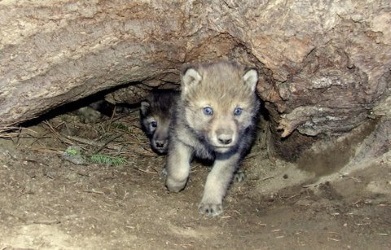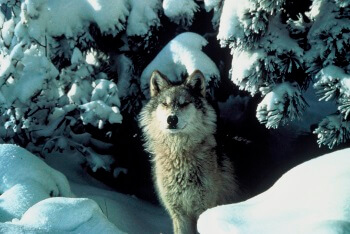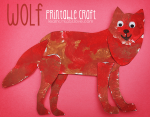Gray Wolf -- School-age
Gray Wolf
Things to Know
The wolf is the ancestor of all breeds of domestic dog. DNA sequencing shows that domestic dogs, once thought to be bred from a mix of canids, in fact descended solely from gray wolves. There is a 0.2% difference between the DNA of a domestic dog, and the DNA of a gray wolf. The gray wolf is part of a group of animals called the wild dogs.
Gray wolves, are the largest wild members of the dog family.
Adults:
Nose-to-tail length between 4.5 and 6ft (1.4 to 1.8m).
Height at the shoulder from 26 to 32 inches (66 to 81cm).
Weight: 50 and 110lbs (22.7 to 50kg). The largest wolf on record weighed 175lbs (79.3kg).
Males are larger than females, and northern wolves are generally larger than those in southern areas. The average lifespan of wolves in the wild is between 6 and 8 years. Wolves in captivity can live up to 17 years.
Its scientific name is Canis lupus, meaning “dog” and “wolf” in Latin. The gray wolf is also known as grey wolf, and the timber wolf. The gray wolf resembles German shepherds or malamutes.
Gray wolves fur can be any shade and mix of gray, black, brown, red, and white. They have gray-brown backs, tan and cream underparts, and long bushy tails. In winter, the fur becomes darker on the neck, shoulders, and rump.
Wolf tracks are about 5 inches long and 4 inches wide. Unlike dogs, wolves tend to travel at a regular pace in straight lines.

Gray wolf tracks in sand.
U.S. Fish & Wildlife Service
Habitat
Gray wolves are one of most widespread land mammals. They occupy a wide variety of habitats, from forest, mountains, grassland and the arctic tundra. Various species of gray wolves can be found in North America, Europe, Asia, as far north as the Canadian Arctic and as far south as India.
Gray wolves use different places to rest. In places experiencing cold, damp, and windy weather they will seek cover. While wolves in dry and warm weather rest in the open.
 Historical (red) and modern (green) range
Historical (red) and modern (green) range
Gray wolf pups emerging from den.
U.S. Fish and Wildlife photo
Dens are usually constructed for pups during the summer period. The female chooses a partner and the animals may remain paired for a number of years. A pregnant female wolf will seek out a den. She will make use of natural shelters, a cleft between rocks, hollow logs, space under a upturned tree, holes thickly covered by vegetation, area under a rock overhang.
Each den has two or more entrances, both are usually marked by a large pile of dirt. Den sights are often near a source of water, and are often elevated so that wolves can detect an approaching enemy. Litter size ranges from 4-6 pups. The Alpha male is very protective of the den.
Video
Behavior
Diet
Gray wolves are carnivores. They eat large hoofed mammals such as bison deer, caribou ,elk, and moose. Wolves often hunt in packs for large prey. They also eat small animals such as beaver, rabbits and hares.
Grey wolves are territorial and live in packs. A wolf pack's territory may cover 20-80 square miles. Wolves hunt in packs for large prey.
Packs
Grey wolves are territorial and live in groups called packs. The alpha male and female are the leaders of the pack. Wolves in the pack work together to hunt, raise their young, and protect their territory.
Communication
Communication is very important and Gray wolves have a very complex communication system. They use sound, scent, and body language to communicate. Wolves howl, yelp, barks, whine, growl, and snarl. Howling is used to assemble the pack, to keep the pack together.
Wolves use scent to communicate, one source is urine, which they use to mark their territory. A wolf's body language is similar to pet dogs. They prance about when they want to play. It will flattened its ears and put its tail between its legs when approaching a dominant animal. If it is confident it will approach another wolf with its head up, ears up, and tail held high.
Story

The Eyes Of The Gray Wolf
by Jonathan London
Stunning pictures with beautifle poetic prose tells of a winter seen through the eyes of Gray Wolf as he roams the wilderness alone.
Video
Things to Do
Video







